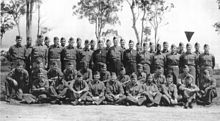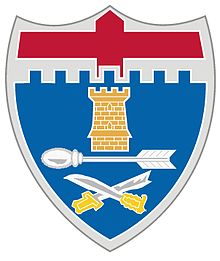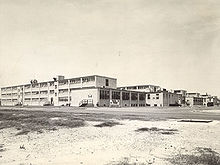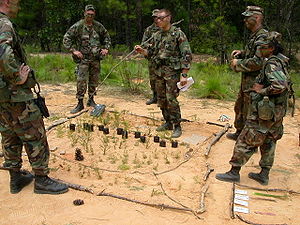- Officer Candidate School (U.S. Army)
-
Officer Candidate School 
The original Officer Candidate School logo. Known today as "the OCS roadwheel" and still in wide use throughout the OCS.Active 1941 — 19/20 Dec 1949, 1951 — present Country United States Branch U.S. Army Type Training Role Train and commission U.S. Army Officers Part of Training and Doctrine Command and the US Army Infantry School Garrison/HQ Fort Benning, Georgia Motto OCS- "Standards, No Compromise" March OCS Alma Mater Commanders Current
commanderLt. Col. John A. Best The United States Army's Officer Candidate School (OCS), located at Fort Benning, Georgia, provides training to become a commissioned officer in the U.S. Army. Officer candidates are drawn from enlisted members (up to Master Sergeant), Warrant Officers, inter-service transfers[1], or civilian college graduates who enlist for guaranteed attendance at OCS after they complete Basic Combat Training (BCT).
Contents
Overview
OCS is a rigorous 12-week course designed to train, assess, evaluate, and develop second lieutenants for the U.S. Army's sixteen basic branches. It is the only commissioning source that can be responsive to the Army's changing personnel requirements due to its short length, compared to other commissioning programs and their requirements. Completing OCS is one of several ways of becoming a U.S. Army commissioned officer. The other methods are:
- Graduation from United States Military Academy (USMA) at West Point
- Completing Reserve Officers' Training Corps (ROTC)
- State-level Officer Candidate Schools programmed by the Army National Guard at Regional Training Institutes (RTI), with curriculum identical to the federal OCS program.
- Direct Commissioning normally is used for accessions of Chaplains, medical professionals, and Judge Advocate General (JAG) lawyers. Currently, the U.S. Army Reserve is using this method in limited numbers for the basic branches as well.
- Interservice Transfer as a commissioned officer of another United States military branch.[2]
- Battlefield commissions, or meritorious commissions, though technically still provided for, have not been used by the US Army since the Vietnam War.
The U.S. Army Officer Candidate School is organizationally designated as 3rd Battalion, 11th Infantry Regiment, 199th Infantry Brigade.[3] It was redesignated from the 3rd Battalion, 11th Infantry Regiment in June 2007. It is a subordinate unit of the Maneuver Center of Excellence (MCoE) also headquartered at Ft. Benning. As of January 2006 the battalion has five training companies and a Headquarters Company in operation, designated HHC, Alpha, Bravo, Charlie, Delta, and Echo—each of which can conduct one class at a time, with a maximum of 160 candidates being trained in each class.[4]
The commander of the 3rd Battalion, 11th Infantry Regiment (OCS), 199th Infantry Brigade is Lt. Col. John A. Best and the Command Sergeant Major Severino.
History
Except where noted, the history is compiled from the official Army history records.
Historically, OCS has provided the means by which the U.S. Army could generate large numbers of junior officers during periods of increasing personnel requirements, typically during wars. Prior to 1973, OCS was branch-specific, at one time there being eight separate schools; by 1964, the Army had consolidated OCS into two schools: Field Artillery OCS at Fort Sill, Oklahoma, and Infantry OCS at Fort Benning. The Vietnam war brought expansion of the OCS program, but it was short lived. In 1973, OCS was made branch immaterial and was consolidated into two courses taught at Ft. Benning, and another at Fort McClellan, Alabama for female Officer Candidates; the course length was reduced to 14-weeks. In 1976, the OCS at Ft. Benning integrated females, and became the only OCS left in the active Army, with the closure of the WAC School. The term "90-day wonders", both as a pejorative and term of affection, has been intermittently applied to junior officers commissioned through OCS since World War II.
World War II era
Officer Candidate School was first proposed in June 1938, as the Army began expanding in anticipation of hostilities when a plan for an officer-training program was submitted to the Chief of Infantry by Brigadier General Asa L. Singleton, Commandant of the Infantry School. No action was taken until July 1940, however, when Brig. Gen. Courtney Hodges, Assistant Commandant of the Infantry School, presented a revised plan to (then) Brig. Gen. Omar Bradley, Commandant of the Infantry School. In July 1941, the OCS stood up as the Infantry, Field Artillery, and Coastal Artillery Officer Candidate Schools, each respectively located at Fort Benning, Fort Sill, and Fort Monroe, Virginia.[5][6]
In addition to the aforementioned programs, there were Officer Candidate Schools stood up for other branches, for instance the Signal Corps at Fort Monmouth, New Jersey. Due to the rapid creation of these programs because of wartime necessity, and then the rapid closures, or restructuring, soon after the end of the war, historical records were not always created or adequately maintained and little is known about many of these branch specific commissioning courses.
The Infantry course, on the other hand is well documented, and it stands today as the precursor of the branch immaterial course taught at Fort Benning. On 27 September 1941, the first Infantry OCS class graduated 171 second lieutenants; 204 men started the 17-week course in July.[7] Testament to the ability of OCS to produce new second lieutenants quickly can be found in War Department decision that ROTC could not fulfill the national demand for officers; so in May 1943, the advanced course in ROTC was suspended and basic course graduates were immediately sent to OCS so they could be commissioned sooner.[8]
During the war, the Army's policy of racial segregation continued among enlisted members; Army training policy, however, provided that blacks and whites would train together in officer candidate schools (beginning in 1942).[9][10] Officer Candidate School was the Army's first formal experiment with integration. Black and white candidates lived separately, but all of the candidates trained together. Despite this integrated training, in most instances, the graduates would go on to join racially segregated units.[10]
 Graduating class of September 1944, SWPA OCS at Camp Columbia, Australia, showing an integrated population.
Graduating class of September 1944, SWPA OCS at Camp Columbia, Australia, showing an integrated population.
General Bradley is credited with establishing the format, discipline, and code of honor still used in OCS today. Bradley emphasized rigorous training, strict discipline and efficient organization. These tenets remain the base values of today's Officer Candidate School. Between July 1941 and May 1947, over 100,000 candidates were enrolled in 448 Infantry OCS classes, of these approximately 67 percent completed the course to earn commissions. After World War II, Infantry OCS was transferred to Fort Riley, Kansas, as part of the Ground General School. Due to the post-war downsizing of the Army and the declining need for new Officers, all but Infantry OCS was closed. Finally, on 1 November 1947, it was deactivated. The final class graduated only 52 second lieutenants.[7]
There was also a school located in the South West Pacific Area (SWPA) at Camp Columbia, Brisbane, Australia.[11] From photographs taken by the U.S. Army it is apparent that this course was integrated, and contemporary records indicate that the course was branch immaterial — perhaps the first branch immaterial course in the Army.[12] Unfortunately, there is little information about the SWPA OCS, and its years of operation and other reliable statistical information are not readily available.
The Women's Army Auxiliary Corps (WAAC) was created by act of Congress on 14 May 1942, permitting them to serve, but not as Soldiers. At that time, women did not have military status and were not integrated into the Army. Their ranks, pay, and benefits were different than the Army, along with all administration. But, being a military organization that was modeled after, and parallel, to the Army, it required a way to train Officers; therefore it created its own WAAC OCS, which stood up on 20 July 1942 at Fort Des Moines, Iowa. The course was six-weeks long, its first class consisting of 440 candidates.[9] Upon graduation, the women were commissioned as third officers (equivalent to a second lieutenant). It is worth noting, that among the first candidates were 40 black women. Initially, black women were segregated, but in keeping with Army policies, integrating officer training, and with pressure from the National Association for the Advancement of Colored People (NAACP), by November 1942, they were being trained in integrated units.[9]
Cold War
With the outbreak of the Korean War, and the Army's rapid expansion in response, the shortage of on-hand officers, and projected commissions, caused the Department of the Army to re-open Infantry OCS at Ft. Benning on 18 February 1951. The course was lengthened from 17 to 22 weeks, as a result of lessons learned from WWII; thus permitting more instruction in Infantry tactics. The Infantry Officer Candidate School became the 1st Officer Candidate Battalion, 2nd Student Regiment. The strength of OCS rapidly increased. As one of eight branch programs, Infantry OCS included as many as 29 companies with a class graduating every week. During the Korean War, OCS commissioned approximately 7,000 Infantry officers.
in April 1949, the U.S. Army established the Women's Army Corps Officer Candidate School at Fort Lee, Virginia. The WAC, an active component of the regular Army, descendant of the WAAC, operated this OCS for females seeking to enter the WAC Officer Corps.[13] The "wash-out" rate was nearly identical to the men's programs, at roughly 37%, during its first four years; an alarming statistic to observers of both programs.[14] By 1954 WAC OCS had been closed and merged with a commissioning program for female direct commissionees, due to the low numbers of women attending the WAC OCS course, due in part to tightened standards for selection — in response to investigations of the washout rates.
On August 4, 1953, the Department of the Army reduced OCS from eight to three programs: Infantry, Artillery, and Engineer, finally closing Engineer OCS in July 1954,[15] leaving only the Infantry and Field Artillery schools open. With the onset of the Vietnam War, however, the OCS program was again expanded with officer candidates undergoing a grueling 23 week program of instruction with an extremely high attrition rate which was designed to prepare young officers to be platoon leaders in a demanding Vietnam jungle environment. In September 1965, Engineer OCS reopened at Fort Belvoir, Virginia, and before closing for good in 1971, over 10,000 Engineer Officers had been commissioned.[15]
As the war in Korea edged into 1953, several classes of Infantry School OCS students were given authorization to transfer to the Medical Service Corps upon graduation. These selected officers (with previous medical experience) were assigned to Korea (after a short training course at Brooke Army Medical Center in San Antonio, Texas), with the explicit duty of trying to keep the direct inductee Medical Officers alive. This was necessary because of the shortage of medical officers and the lack of combat preparation training provided to them after their direct induction into the army upon filing their first papers for citenzenship in the United States and their immediate assignment to Korea.
This the height of the Vietnam War, Infantry OCS produced 7,000 officers annually from five student battalions, all located at Ft. Benning. Also, during the war, a female OCS was once again established; it was stood up at Fort McClellan, Alabama, as part of the WAC Center and School. Other OCS programs were located at Fort Gordon, Georgia (Signal Corps); Fort Sill, Oklahoma (Artillery), Fort Lee, Virginia (Quarter Master),Fort Eustis, Virginia (Transportation), Fort Knox, Kentucky (Armor), Fort Belvoir, Virginia (Engineer) and Aberdeen Proving Ground, Maryland (Ordinance). In April 1973, a branch immaterial OCS was established at Fort Benning, ending the Infantry and Field Artillery based courses. In 1976, with the end of the gender separate Army, the women's OCS was merged with the branch immaterial male course, creating a program very similar to the modern OCS. The United States Military Academy at West Point, New York, also admitted its first female cadets in 1976. However, due to the length of instruction there (4 years), the newly gender integrated Officer Candidate School had the distinction of commissioning a female second lieutenant before USMA.
Modern OCS
OCS Candidates preparing for a mission on a "sand table".
Today, Officer Candidate school is offered in two ways. Active duty OCS is a 12-week long school, taught "in residence" at Ft. Benning, Georgia. Its primary purpose is to commission Second Lieutenants into the Active Army, with a secondary purpose of training selected individuals for Reserve duty as commissioned officers.[citation needed]
The Army National Guard also runs OCS at Regional Training Institutes (RTI) in many states. This is the same program of instruction as the OCS program conducted at Fort Benning and are accredited every three years through Fort Benning.[citation needed]
Active Duty
The Army's Officer Candidate School is programmed to teach basic leadership and Soldier tasks, using the Infantry battle drills found in Army Field Manual 3-21.8 as a framework for instruction and evaluation of leadership potential. A total of 71 tasks are taught and tested while at OCS. A candidate should expect to be under constant observation and evaluation by their cadre. Mental and emotional stress is induced through a variety of controlled methods, to test problem solving and moral resolve. Additionally, the course is meant to be physically demanding, with numerous tactical road marches, timed runs of varying distance from 2 miles to 5 miles, and Army Combatives training. Beginning with the first class of FY 2008, the calendar length of OCS was shortened from 14 weeks to 12 weeks, thus allowing for more classes to be conducted each Fiscal Year; thereby raising the maximum capacity of the school to train Second Lieutenants to meet future commissioning needs as the Army grows. The current capacity of each class that is conducted is limited to 160 Officer Candidates.[citation needed]
Officer Candidate School is conducted in two phases: basic phase; and senior phase. Students are referred to as either Basic Officer Candidates (BOCs) or Senior Officer Candidates (SOCs) as their classes progress. Initially, upon arrival, the candidates have very few privileges, and enter into a controlled environment similar to BCT, although they are expected to act like leaders and take charge and responsibility immediately. As they progress through the course, they may earn and request privileges. Their bearing, deportment, and behavior, both individually and collectively, will affect the return of their privileges.[citation needed]
In September 2010, OCS implemented a policy of total immersion. This system removes the possibility of candidates earning on- or off-post passes and using their vehicles during the first 6 weeks of school, restricts the consumption of alcohol to 2 designated days during the course, and prohibits students to carry cell phones while in uniform.[citation needed]
All candidates are commissioned as Second Lieutenants upon graduation.[citation needed]
Army National Guard
The program at the RTI's is offered in two different formats to accommodate the reserved component citizen soldiers. The traditional OCS program is a 16 month course of instruction conducted from April to August of the following year and is broken down into four phases: Phase 0 - is two drill weekends and designed to prepare Officer Candidates for the OCS program. Phase 1 - is a 15 day annual training period held in June. Phase II - is conducted one weekend per month for a period of 13 months. Phase III - is a final 15 day annual training period, culminating with graduation and commissioning. The Army National Guard also offers an "Accelerated" OCS program which is a 56 day, full-time program. Upon successful completion of Army National Guard OCS the candidates are commissioned Second Lieutenants if they possess at least 90 semester hours, and must complete Basic Officer Leadership Course (BOLC) II and III within 24 months. The commission received from this version of OCS is the same federally-recognized commission as offered through Fort Benning OCS.[citation needed]
It is interesting to note that in TY 2009 the U.S. Army will begin sending soldiers to the accelerated OCS program conducted by the National Guard RTI's. This was determined to be a more cost efficient way of producing officers compared to expanding the Fort Benning program.[citation needed]
Basic Officer Leadership Course
Beginning in 2001, the Army began to experiment with a new course, called Basic Officer Leadership Course (BOLC). In short, through several test phases, and program of instruction reviews, the course was established in 2006 as a branch immaterial leadership course, and renamed BOLC II. BOLC I is an Officer's commissioning source, for example, ROTC, USMA, or OCS; while BOLC III is their branch specific Officer Basic Course (OBC). BOLC II is 7-weeks in length, and designed to ensure that all new Officers, regardless of commissioning source (to include JAG and most Medical Service Corps Direct Commissionees), are at the same level with basic leadership skills, individual Soldier skills (such as physical fitness and weapons qualification), Infantry tactics, and the orders process. Certain non-prior service commissionees, such as doctors who get directly commissioned, attend a variation of BOLC II known as Officer Basic Leadership Course (OBLC). It is primarily for Medical Service specialties like Doctors and Surgeons who have no prior service with the military and takes place at Fort Sam Houston, Texas. It includes all the normal OBC classes, but includes a segment on basic soldiering skills such as marching, customs and courtesies, and rank structure.[citation needed]
In 2009, the Army streamlined the Officer training pipeline by removing BOLC II and renaming BOLC I to BOLC-A and BOLC III to BOLC-B. Three weeks of training was added to BOLC-B which includes basic soldiering skills such as land navigation and weapons qualification.[16]
This is the only possibility of attaining an officer's commission without the prerequisite of having a bachelors degree. There are, however, requirements that allow basic qualification for entrance into Officer Candidate School for the Army Reserves. These include having at least 90 credits from an accredited college, approval from the Officer Candidate School board, and falling in the age range of 18 to 41 years.[citation needed]
The Officer Candidate School Hall of Fame
The U.S. Army Officer Candidate School[17] Hall of Fame was established in 1958 to honor Infantry Officer graduates of the Officer Candidate School Program who distinguished themselves in military or civilian pursuits. In 2002 the Hall of Fame was opened to graduates from all U.S. Army Officer Candidate Schools from across the history of the U.S. Army.
Selection and induction into the Hall of Fame is not guaranteed. The qualifying criteria for selection are as follows:
- Commissioned from any active component Army OCS program and accomplished one of the following:
- (1) Awarded the Medal of Honor
- (2) Attained the rank of Colonel while serving on active duty or the reserves.
- (3) Elected or appointed to an office of prominence in the national or state government.
- (4) Achieved national or state recognition for outstanding service to the nation.
- (5) Attained an exceptional wartime service record.
All U.S. Army Officer Candidate School Hall of Fame inductees are considered notable. There are over two thousand inductees; just a few of them are listed here to represent all the others:
- General John Shalikashvili
- Honorable Hugh J. Addonizio
- Honorable William F. Buckley, political commentator
- Major General George F. Close Jr.
- Honorable Robert J. Dole politician
- Colonel Leland B. Fair
- Lieutenant Colonel Don C. Faith, Jr
- General Tommy Franks
- Colonel Ronald F. Fraser
- Major General Michael D. Healy
- Colonel John L. Insani
- Major General Phillip Kaplan
- General Robert C. Kingston
- Brigadier General Julia A. Kraus
- General Frederick J. Kroesen, Jr.
- Colonel Leo J. Meyer
- Colonel Robert Nett
- Brigadier General Belinda Pinckney
- Colonel Alan Reich
- Honorable Rick Rescorla
- Honorable Winthrop Rockefeller
- Colonel Archibald D. Scott III
- Colonel Carolyn R. Sharpe
- Lieutenant Colonel Wilbur A. "Sid" Sidney
- Honorable Caspar Weinberger Secretary of Defense
- Lieutenant General David S. Weisman
- Major Dick Winters, whose service was portrayed in "Band of Brothers"
OCS Alma Mater
Old Benning School for Boys:
Far across the Chattahoochee, to the Upatoi, Stands our loyal Alma Mater, Benning School for Boys, Forward ever, backward never, faithfully we strive, To the ports of embarkation, follow me with pride, When it's time and we are called to guard our country's might, We'll be there WITH OUR HEADS HELD HIGH, in peacetime and in fight, Yearning ever, failing never, to guard the memory, The call is clear; we must meet the task [for] FREEDOM'S NEVER FREE!
Current OCS:
Far across the Chattahoochee, to the Upatoi, OCS our Alma Mater, Benning's pride and joy, Forward ever, backward never, faithfully we strive, To the ports of embarkation, follow me with pride, When it's time and we are called to guard our country's might, We'll be there WITH OUR HEADS HELD HIGH, in peacetime and in fight, Yearning ever, failing never, to guard the memory, The call is clear; we must meet the task [for] FREEDOM'S NEVER FREE!
Notes and references
- ^ In this case, Inter-Service Transfer refers to enlisted members of the U.S. Air Force, U.S. Navy, or U.S. Marine Corps transferring to the U.S. Army to attend OCS.
- ^ Army Regulation 614-120 Interservice Transfer of Army Commissioned Officers on the Active Duty List para 2-5 Application of officers of other uniformed services
- ^ 199th Infantry Brigade
- ^ ATRRS Course Catalog
- ^ Field Artillery OCS History
- ^ Coastal Artillery OCS History
- ^ a b OCS History
- ^ Hoya Battalion History
- ^ a b c Women's Army Corps http://www.history.army.mil/books/wac/chapter1.htm#p5 Chapter I "The Women's Army Corps, 1942-1945"]
- ^ a b Integration of the Armed Forces: 1940-1965 Chapter 2 "World War II: The Army"
- ^ South West Pacific Area OCS
- ^ Officer Candidate School, Camp Columbia near Brisbane, Queensland, Australia, during WWII
- ^ More Military Women Firsts and Accomplishments
- ^ "Chapter V: Officer Procurement and Career Development" Women's Army Corps
- ^ a b Engineer OCS
- ^ http://www.armytimes.com/news/2009/12/army_leadership_training_121409w/
- ^ https://www.benning.army.mil/ocs/content/hall_of_fame/hall_of_fame.htm
See also
- Military academy
- Officer Candidate School
- Training and Doctrine Command
External links
- The Official Army OCS Website Official Army website of the Officer Candidate School
- 11th Infantry Regiment: OCS History
- ArmyOCS.com Website operated by the OCS Foundation, dedicated to supporting the Officer Candidate School
- History of the 199th Light Infantry Brigade (Separate)
- The Army OCS Alumni Website Website of the Army Officer Candidate School Alumni
Sub-commands - Accessions Command
- Center for Army Lessons Learned
- Combined Arms Center
- Combined Arms Support Command / Sustainment Center of Excellence
- TRADOC Analysis Center

Installations Schools - Air Assault School
- Air Defense Artillery School
- Airborne School
- Armor School
- Aviation School
- Basic Training
- CBRN School
- Sniper School
- Combatives School
- Command and General Staff College
- Defense Language Institute
- Engineer School
- Field Artillery School
- Infantry School
- Intelligence Center
- Jumpmaster School
- Army Logistics University
- Mountain Warfare School
- Officer Candidate School
- Pathfinder School
- Prime Power School
- Quartermaster School
- Ranger School
- School of Advanced Military Studies
- Sergeants Major Academy
- Special Forces Qualification Course
- Soldier Support Institute
- War College
- Warrant Officer Candidate School
- United States Military Academy (West Point)
Leadership Secretary of the Army · Under Secretary of the Army · Chief of Staff · Vice Chief of Staff · 4-star generals · Sergeant Major of the Army · House Armed Services Committee (House Subcommittee on Air and Land Forces) · Senate Committee on Armed Services (Senate Subcommittee on Air and Land Forces)

Components and
commandsArmy CommandsService ComponentsForces · Africa · Central · Europe · Pacific · North · South · Special Operations · Surface Deployment and Distribution · Space and Missile Defense
Direct Reporting UnitsNetwork Enterprise Technology · Medical · Intelligence and Security · Criminal Investigation · Corps of Engineers · Military District of Washington · Test and Evaluation Command · Military Academy · Reserve · Acquistion Support Center · Installation Management
Field ArmiesBranchesAcquistion Corps · Adjutant General's Corps · Air Defense Artillery Branch · Armor Branch · Aviation Branch · Army Band · Chaplain Corps · Chemical Corps · Civil Affairs Corps · Corps of Engineers · Dental Corps · Field Artillery Corps · Finance Corps · Infantry Branch · Inspector General's Corps · Judge Advocate General's Corps · Logistics Branch · Medical Corps · Medical Service Corps · Medical Specialist Corps · Military Intelligence Corps · Military Police Corps · Nurse Corps · Ordnance Corps · Psychological Operations Corps · Quartermaster Corps · Signal Corps · Special Forces · Transportation Corps · Veterinary Corps
Installations Training Uniforms and insignia Equipment History and traditions History · Continental Army · National Army · Army of the United States · United States Army Air Forces · Center of Military History · Institute of Heraldry · America's Army · Army Art Program · Army Band · Old Guard Fife and Drum Corps · Flag · National Museum · Rangers · Soldier's Creed · The Army Goes Rolling Along · Draft · Service numbersCategories:- United States Army schools
Wikimedia Foundation. 2010.




